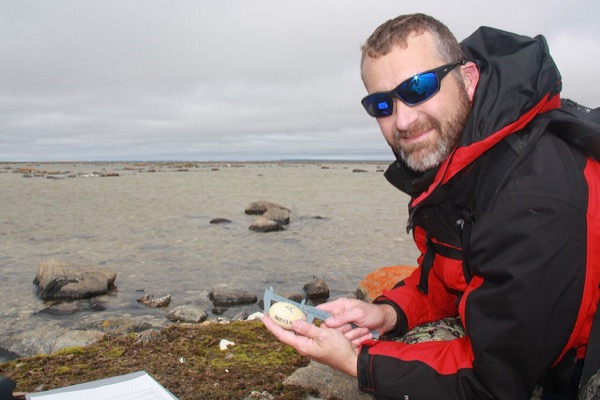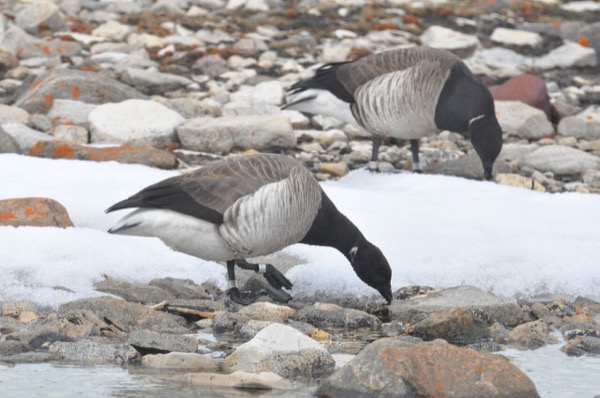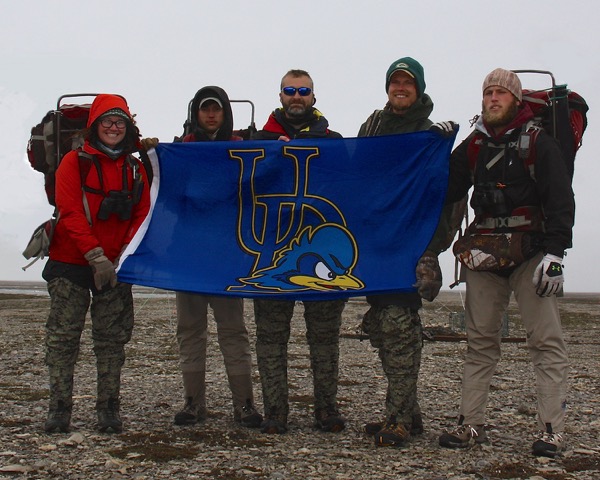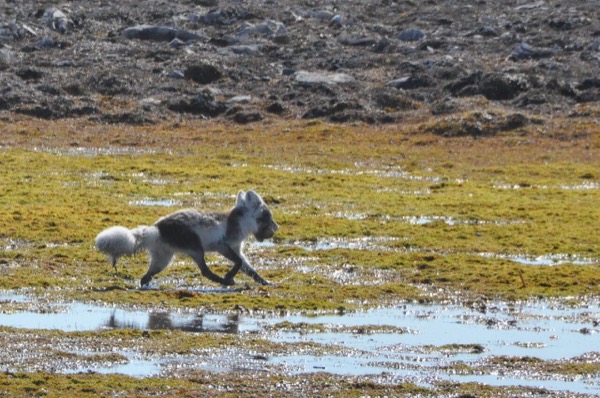

Goose camp
Researchers look at impact of competing geese, Arctic fox predation on Atlantic brant nests
4:02 p.m., April 27, 2016--When the University of Delaware’s Chris Williams traveled to Southampton Island in Canada’s north Hudson Bay in the summer of 2015 to study the nesting sites of the Atlantic brant goose, the last thing he and his research group expected to run into was a fellow Mid-Atlantic resident. But as he scoured the scenery one day, he found someone else who made the trip in the form of a red knot.
Red knots are shorebirds that come north through the Delaware Bay on their trip from South America to the Arctic, eating horseshoe crabs to refuel on their trip.
Research Stories
Chronic wounds
Prof. Heck's legacy
Williams said he was pleased to get a photograph of the bird, which had a leg flag markings J7V that was last re-sighted in 2010 and 2011 around Cape May, New Jersey.
“It was fantastic to run into this little bird that had made the long trip north just like us,” said Williams, associate professor of wildlife ecology who oversees a Waterfowl and Upland Gamebird research program in UD’s College of Agriculture and Natural Resources.
Brant in decline
The focus of the research team, which includes UD graduate student Clark Nissley, was on the Atlantic brant goose, a bird whose population has been fluctuating and on a moderate decline for many years, to learn if limitations during the summer breeding season have accelerated that trend.
The brant has a number of factors working against it, beginning with its size. Because the brant is smaller than the other two birds that nest in the area — snow geese and cackling geese — it is at a disadvantage when competing for habitat and food.
Also due to its size disadvantage, the brant arrives at its breeding grounds later than the other geese, which can build up larger fat reserves prior to make the trip north, enabling them to make fewer stops to the Arctic nesting grounds. The smaller brant, on the other hand, must stop more along the way in order to feed and rebuild its fat stores. Because of these delays, the brant arrive about 1-2 weeks after lesser snow geese and cackling geese causing them to miss out on prime nesting real estate.
This prime real estate can help shield the nests from predators, specifically the Arctic fox, and this year the researchers decided to focus extra effort on the foxes to see how much of an impact they have on the nest success.
Arctic fox predation
Arctic foxes are the biggest predators of the goose eggs, though there are a number of other animals that will eat them — such as parasitic jeagers, herring gulls, and polar bears — but the one thing the researchers noticed last year was that the foxes would sometimes be unable to reach a nest if it was located on a small island, just a handful of square meters, that was surrounded by deeper water.
“What we were seeing anecdotally last year was the cackling geese were nesting on islands with deep water around them but when the brant came in late, they couldn’t choose those areas and so they were left nesting on islands that were not as well protected by deeper water. The Arctic foxes could just annihilate them,” said Williams.
This year, the researchers spent more time focusing on foxes to identify the number. They marked them and identified them on nest cameras to get a better idea of the impact of fox predation. They also measured the water depths around all the nests and found that this year, once the water was deeper than 20 centimeters, fox depredation of nests dropped off substantially.
Williams said that this was an interesting year for the researchers as weather conditions caused a late thaw, which made it harder for the birds that arrived earlier — the snow geese and the cackling geese — to nest effectively.
“It was a wickedly cold year up there this year, one of the coldest they’ve seen in a long time, and so it was ice covered. The snow geese arrived first and, in theory, they are trying to time their landing just right in the Arctic when the icy tundra starts to melt. But this year nothing melted, so the snow geese hung around for a little bit but, ultimately, had almost a complete nesting failure,” said Williams.
The cackling geese came in right as the ice was starting to melt but the number of nesting sites was reduced by 38 percent from last year due to the ice coverage.
“For migratory geese, when it comes to migrations, they are most driven by light cycles. Their internal clock is saying, ‘It’s time to leave and get up to the Arctic.’ They are hoping to time their migration just right to take advantage of recently thawed land for nesting and feeding, get through the nesting cycle, and then leave for the south before the weather turns again in the arctic. It is a relatively small window. However, if you arrive too early in the Arctic it can be devastating for physiological health and nesting success. Big geese with extra fat can take this chance. However, I think brant take the exact opposite evolutionary strategy and say, ‘Well, we’re small and it takes us a while to get up there, but we can guarantee that when we do get up there, everything will have melted and there are plants growing, so I’ll have things to eat when I land,’” said Williams.
It’s basically a bet-hedging strategy and Williams said that could explain why the brant numbers show a lot of fluctuation over the last 70 or 80 years.
“I think what is happening is that there are good years and bad years based on weather and now competition is adding an additional complexity to brant success. The cackling goose population has exponentially increased and has inserted itself into the equation – something that was not there 30 years ago when brant populations were much more robust,” said Williams.
Unlucky goose
This year seemed like a perfect opportunity for the brant population to thrive but the only problem was that this fortuitous weather cycle also coincided with a dramatic drop in the lemming population which cycles every 3-4 years and which are the other main food source of the Arctic fox.
“On one hand I would suggest this was going to be a growth year for brant because they came into an environment where there was almost no competition for nest sites and food and so nest production could theoretically be high. However, since there were almost no lemmings for foxes to eat, they had to rely primarily on bird eggs. While geese were hit hard, shorebirds nests were almost completely decimated across the study area,” said Williams.
While the brant did have more nesting success this year than last, Williams said that it was still not likely enough to rebound the low population. “They initiated almost twice as many nests as last year but their nest success was still a paltry 17 percent this year compared to 6 percent last year. However, given the numerous odds stacked against the brant, it is scary what is in store for their future,” said Williams.
Williams’ research is funded by the Arctic Goose Joint Venture and the Polar Continental Shelf Program, which is a division of Natural Resources Canada.
Nissley has also received scholarships funds to help with the project from California Waterfowl through the Dennis Raveling Scholarship for Waterfowl Research and from Long Point Waterfowl through the Dave Ankney and the Sandi Johnson Waterfowl and Wetlands Graduate Research Scholarship.
Article by Adam Thomas
Video by Jeffrey C. Chase












